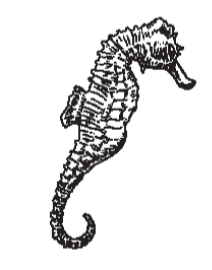What is it about aquariums? Walk into the cool, humming darkness of the zoo’s aquatic counterpart and something magical happens. Burbling blue light, darkened corridors, a silvery flash of fin, a ripple of aquatic wings: aquariums quiver with the promise of unearthly visions. In The Lady from Shanghai, Orson Welles’s passionate clinch with Rita Hayworth unfolds before an aquarial tank: the aquarium’s allure, after all, is not unlike the appeal of illicit sex. Aquariums, like adultery, draw us into a shadowy underworld of unspoken sensual pleasures, an engrossing, exotic environment harboring dangers of mythic proportion.
It’s partly the mystery of it all. The ocean has long been our repository for ideas of the monstrous and the unknowable. “Canst thou draw out leviathan with a hook?” God demands of Job. We can’t control the sea’s creatures—we can barely comprehend them. They challenge our most basic ideas of creatureliness. Creatures have recognizable parts—but in the sea they can be diaphanous clouds of membrane, without eyes, face, stomach, spine, or brain. Creatures move, but oysters drift, and corals are rooted like plants. Creatures have physical integrity, but a starfish chopped in half will grow into two separate beings. Or consider the Portuguese man-of-war, a creature that acts like an individual but is actually a huge colony of beings moving as one. There are fish that can freeze without dying, and other sea creatures living at temperatures above boiling. Recent research around volcanic vents has found tiny organisms that breathe iron. As for reproduction, even the most ordinary fish can be deliriously perverse. They’re hermaphrodites. They switch genders. Males give birth. Some corals and bivalves reproduce by “broadcast spawning,” in which males cast off huge nets of sperm that drift capriciously to any available egg, while snails and leeches mate through what scientists call “traumatic insemination,” where the male fires a detachable sperm-filled harpoon at the unsuspecting body of a female—Jesse James meets Johnny Wad.
As naturalist Loren Eiseley once wrote, “If there is magic on this planet, it is contained in water.”
A visit to an aquarium does little to diminish this sublime terror. Even as it strives to inform, with wall copy and touch screens and neat placards of exhibit-speak, the aquarium mesmerizes visitors, over-flowing and short-circuiting its own pedantic intent. No touch screen on earth can match the allure of a live reef shark, rippling your way with a sinister, toothy smile.
We must love this. Aquariums are currently all the rage. Of the forty-one American aquariums accredited by the American Zoo and Aquarium Association in 2003, more than half opened since 1980, sixteen since 1990 alone.These are not traditional halls of fish tanks but huge, immersive environments with...
You have reached your article limit
Sign up for a digital subscription and continue reading all new issues, plus our entire archives, for just $1.50/month.
Already a subscriber? Sign in





